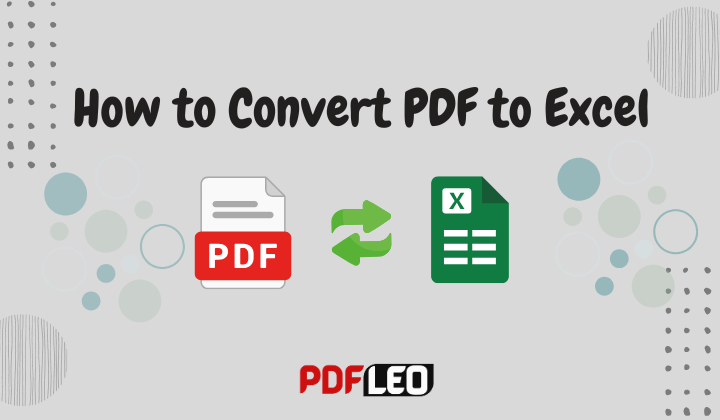In today’s digital landscape, managing and analyzing data is crucial for everyone—from students and professionals to business owners and researchers. Many of the documents we work with are in PDF format. While PDFs are great for sharing and viewing, they aren’t the most convenient when it comes to editing or analyzing data. That’s why learning how to convert PDF to Excel can save time, boost productivity, and improve accuracy.
This comprehensive guide will teach you everything about how to convert PDF to Excel, including the best tools, step-by-step instructions, common problems, and expert tips for accurate conversions.

Table of Contents
ToggleWhy Learn How to Convert PDF to Excel?
Here are the top reasons why knowing how to convert PDF to Excel is important:
-
Editability: Excel allows you to edit, format, and calculate your data with ease.
-
Data Analysis: Excel’s powerful tools—such as pivot tables, graphs, and formulas—help analyze data effectively.
-
Automation: After you convert data, Excel allows you to automate tasks with scripts and macros.
-
Time-saving: Manual data entry is time-consuming. Learning how to convert PDF to Excel simplifies the process.
-
Accuracy: Extracting data using a tool reduces human error.
Whether you’re dealing with financial reports, product inventories, student records, or surveys, knowing how to convert PDF to Excel makes your work more manageable.
Different Methods on How to Convert PDF to Excel
There are multiple methods to learn how to convert PDF to Excel. Depending on your needs and technical expertise, you can choose from online tools, desktop software, or built-in tools like Microsoft Office or Google Drive.
1. Using Online Tools – The Easiest Way to Learn How to Convert PDF to Excel
Online converters are a fast and free option for people who want to understand how to convert PDF to Excel without installing software.
Top Online PDF to Excel Converters:
-
iLovePDF
-
Smallpdf
-
PDF2Go
-
SodaPDF
Steps:
-
Visit an online converter site like PDFLeo.com.
-
Upload your PDF file.
-
Click “Convert to Excel” or a similar button.
-
Download the converted
.xlsxfile.
Pros:
-
Quick and user-friendly.
-
No need to install software.
-
Works on any device.
Cons:
-
Limited usage for free users.
-
Internet required.
-
Not suitable for sensitive data due to potential privacy risks.
If you’re just starting out and want to explore how to convert PDF to Excel without commitment, online tools are the best way.
2. How to Convert PDF to Excel Using Adobe Acrobat Pro DC
Adobe Acrobat Pro DC offers one of the most professional and accurate ways to handle PDF conversions.
Steps:
-
Open your PDF in Adobe Acrobat Pro DC.
-
Click “Export PDF” from the right-hand toolbar.
-
Choose “Spreadsheet” → “Microsoft Excel Workbook.”
-
Click “Export” and save the file.
Pros:
-
Excellent formatting retention.
-
Supports scanned PDFs using OCR.
-
Reliable for business use.
Cons:
-
Requires a paid subscription.
-
Slightly complex for beginners.
Professionals who frequently ask how to convert PDF to Excel with full layout preservation should consider this method.
3. How to Convert PDF to Excel Using Microsoft Word and Excel
If you already have Microsoft Office, you can convert a PDF to Excel using Word and Excel in a simple workaround.
Steps:
-
Right-click your PDF file and open it with Microsoft Word.
-
Word will automatically convert the PDF into editable text.
-
Copy any tables or relevant data.
-
Paste the data into Microsoft Excel.
Pros:
-
No need for extra tools.
-
Simple for light users.
Cons:
-
Formatting may be altered.
-
Not ideal for complex tables.
This method is a helpful solution for people wanting to understand how to convert PDF to Excel using tools they already have.

4. How to Convert PDF to Excel Using Google Drive
Google Drive is another free and accessible way to convert PDF content into an Excel-readable format.
Steps:
-
Upload your PDF to Google Drive.
-
Right-click the file and select “Open with Google Docs.”
-
Copy the tables or data displayed.
-
Paste the content into Google Sheets.
-
If needed, download as an Excel file (
.xlsx).
Pros:
-
100% free.
-
Cloud-based access.
-
No software needed.
Cons:
-
Often loses formatting.
-
May not extract data accurately from scanned PDFs.
For those using Chromebooks or Google Workspace, this is a great way to learn how to convert PDF to Excel with cloud tools.
5. How to Convert PDF to Excel Using Desktop Software
If you work with documents regularly, desktop applications offer a more robust solution.
Recommended Tools:
-
Wondershare PDFelement
-
Foxit PDF Editor
-
Nitro PDF Pro
-
Able2Extract Professional
Features:
-
Batch conversion.
-
OCR support for scanned documents.
-
Better control over data extraction.
Pros:
-
Accurate conversions.
-
Offline functionality for secure data.
-
Suitable for large files and complex layouts.
Cons:
-
Software installation required.
-
Usually not free.
This is the go-to choice for professionals who want to master how to convert PDF to Excel reliably and frequently.
How to Convert PDF to Excel with Scanned Files
Sometimes, the PDFs you want to convert are scanned images. In this case, you’ll need a tool with OCR (Optical Character Recognition) support.
Tools with OCR:
-
Adobe Acrobat Pro DC
-
Wondershare PDFelement
-
Smallpdf (Premium)
OCR reads text from images and converts it into editable Excel data.
Learning how to convert PDF to Excel with OCR ensures you can extract data even from photos, scanned invoices, or printed records.
Tips for Accurate PDF to Excel Conversion
Here are expert tips to improve your results when learning how to convert PDF to Excel:
Choose the Right Tool
Test multiple tools to find the one that works best with your document layout and formatting.
Avoid Scanned Files (If Possible)
Text-based PDFs convert much more accurately than scanned ones.
Clean Your PDFs
Remove unnecessary graphics, watermarks, or complex formatting before conversion.
Split Large Files
Break big PDFs into smaller sections for better accuracy.
Review the Output
Always check the Excel file post-conversion. Clean up formatting, fix merged cells, and double-check calculations.
Common Problems When Converting PDF to Excel and Solutions
| Problem | Solution |
|---|---|
| Data appears as an image | Use an OCR-enabled tool |
| Formatting issues | Try Adobe Acrobat or desktop software |
| Extra or missing rows | Clean the source PDF and try again |
| Data in one column | Use Excel’s “Text to Columns” tool |
Learning how to convert PDF to Excel also involves understanding how to troubleshoot typical conversion issues.
Real-Life Use Cases: Why You Need to Know How to Convert PDF to Excel
Finance
Convert bank statements, invoices, or tax reports for quick Excel-based accounting.
Inventory Management
Extract product lists and stock reports from supplier PDFs into Excel for sorting and editing.
Business Reports
Move static PDF analytics or performance summaries into Excel dashboards.
Education & Research
Convert student grades, test results, or tabular research data from PDF to Excel for analysis.
Human Resources
Transfer employee records, payslips, or attendance logs from PDFs to spreadsheets.
Automating the Process: How to Convert PDF to Excel Using Python
For developers or companies handling bulk conversions, learning how to convert PDF to Excel using Python can save hours.
Sample Code Using Tabula:
import tabula
# Convert PDF file to Excel
tabula.convert_into(“sample.pdf”, “output.xlsx”, output_format=“xlsx”, pages=‘all’)
Other useful libraries:
-
camelot -
PyMuPDF
Post-Conversion Tips in Excel
After you convert your file, enhance your spreadsheet using:
-
Remove Duplicates – Clean up redundant entries.
-
Conditional Formatting – Highlight patterns and trends.
-
Sort & Filter – Analyze your data more effectively.
-
Pivot Tables – Summarize large datasets quickly.
Understanding how to convert PDF to Excel is just the start; post-processing in Excel is equally important.
Tool Comparison Table: Which Method Should You Choose?
| Method | Ease of Use | Accuracy | Cost | Best For |
|---|---|---|---|---|
| Online Tools (e.g., PDFLeo) | ★★★★★ | ★★★★☆ | Free | Beginners, light use |
| Adobe Acrobat Pro | ★★★★☆ | ★★★★★ | Paid | Business use, OCR |
| Microsoft Word + Excel | ★★★☆☆ | ★★☆☆☆ | Free | Simple data tables |
| Google Drive & Sheets | ★★★★☆ | ★★☆☆☆ | Free | Cloud users |
| Desktop PDF Software | ★★★★☆ | ★★★★★ | Paid | Heavy users, secure data |
| Python Automation | ★★★☆☆ | ★★★★★ | Free | Developers |
Final Thoughts on How to Convert PDF to Excel
Knowing how to convert PDF to Excel is a vital skill in today’s data-driven world. It allows you to transform static documents into dynamic spreadsheets, enabling deeper analysis, quicker editing, and better decision-making.
Whether you’re a student managing coursework, a business handling transactions, or an analyst crunching numbers, understanding how to convert PDF to Excel makes your workflow smoother and smarter.

Start experimenting today and find the best tool or method that suits your needs. And remember—accuracy, privacy, and flexibility matter. Choose wisely and master this essential skill.
Try It Now
Need a fast, secure, and free solution? Head over to PDFLeo.com to instantly learn how to convert PDF to Excel—no signup required!

